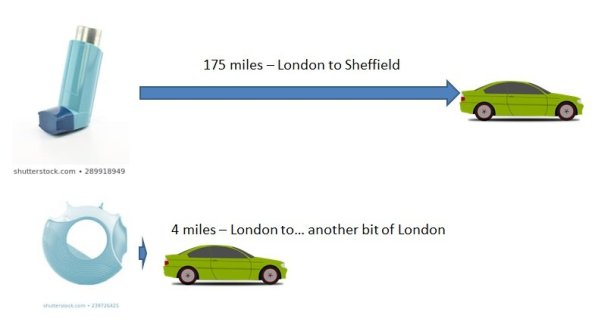Reducing the Carbon Footprint of your doctor’s surgery
The Lennard Surgery is committed to helping the NHS reach their target of being totally carbon neutral by 20401.
We are currently reviewing our own practices to look for changes we can make to help shape an environmentally friendly and sustainable future by reducing our carbon footprint.
One change that we have identified is converting patients from Metered Dose Inhalers (MDIs) to Dry Powder Inhalers (DPIs) where appropriate.
This conversion is something that we all at The Lennard Surgery feel passionately about. To make a real change we will need the help of our patients, especially you!

What are metered dose inhalers and dry powder inhalers?
MDIs use a pressurised propellant within the aerosol chamber to help administer the medicine. The propellants used in these inhalers are potent greenhouse gases which cause damage to the ozone layer.
DPIs are newer inhalers, where the medicine is released when the patient breathes in on the inhaler. This means that there is no need for the pressurised propellant.
Why are these inhaler changes important?
Inhalers contribute to roughly 3.5% of the NHS’ total carbon footprint2.
As mentioned, MDIs use greenhouse gases as their propellants. This means that, on average, 100 doses of an MDI releases carbon emissions equivalent to that released during a 180-mile drive in a car3. On the other hand, DPIs release 18 times LESS carbon emissions that MDIs4.
Climate change is also an important determinant of social and physical health5. In other words, reducing climate change will not only have a positive impact on the environment, but it will also improve our health in general.
How will changing to a DPI affect me?
The medication and dose that you receive will remain same, so it should not have any impact on your health. The only aspect that will change is device that delivers the medication.
Some people find the DPIs are easier to use as they do not require the hand-breath coordination that is required by MDIs6. Although some people may find that they prefer their original MDI.
Of course, should you decide that you prefer your original MDI after trying the DPI, you can always be switched straight back.
Inhaler technique
When changing over inhalers it is important that patients know the correct technique for their new inhaler.
You can visit the links (External) below which show the correct technique for some inhalers:
Fostair NEXThaler: https://www.asthma.org.uk/advice/inhaler-videos/nexthaler/
Beclomethasone Easyhaler: https://www.asthma.org.uk/advice/inhaler-videos/easyhaler/
Salamol pMDI: https://www.asthma.org.uk/advice/inhaler-videos/pmdi/
What happens next?
At your next asthma or COPD review, we will discuss any possible changes to your inhalers. Your health comes first, so changes will only happen if it is suitable for the patient.
We plan to review our Ventolin prescribing. This is the most commonly used inhaler in the UK. Ventolin is actually the brand name (like hoover for vacuum cleaners), and the active ingredient is Salbutamol. Ventolin is a particularly large volume inhaler with lots of propellant in. Changing to a smaller volume metered dose inhaler, such as Salamol, means a lot less of the harmful propellant is released into the environment.
Ventolin Evohaler – Approx. 28kgCO2e per inhaler compared to Salamol – Approx. 10kgCO2e per inhaler
Remember good asthma control looks like using your blue inhaler only 3 times per week or 2 inhalers a year.
Recycle?
All used inhalers should be returned to a pharmacy to be disposed of safely.
They can be disposed of by the pharmacist with other drugs waste, this is then thermally treated to destroy the greenhouse gases. This environmentally safe disposal route is available at all pharmacies7
- NHS England. Delivering a ‘Net Zero’ National Health Service. https://www.england.nhs.uk/greenernhs/wp-content/uploads/sites/51/2020/10/delivering-a-net-zero-national-health-service.pdf (EXTERNAL LINK).
- NHS Sustainable Development Unit. Sustainable Development in the Health and Care System: Health Check;2016. https://www.sduhealth.org.uk/documents/publications/2016/20160310%20SDUupdate%20FINAL%20CR%20update.pdf (EXTERNAL LINK).
- NICE National Institute for Healthcare and Excellence: asthma patient decision aid. https://www.nice.org.uk/guidance/ng80/resources/inhalers-for-asthma-patient-decision-aid-pdf-6727144573
- British Thoracic Society (BTS) (2019) Position Statement: Environment and Lung Health. https://www.brit-thoracic.org.uk/document-library/governance-and-policy-documents/position-statements/environment-and-lung-health-position-statement-2019/
- Watts N, Amann M, Arnell A, et al. (2018). The 2018 report of the Lancet Countdown on health and climate change: shaping the health of nations for centuries to come. Lancet, 392(10163):2479–2514
- Desai, H. & Dala, B. (2012) Management Options in Chronic Obstructive Pulmonary Disease. Clinical Medicine Insights: Therapeutics. 4(4):273-285.
- Recycle Now (2021) What to do with INHALERS.https://www.recyclenow.com/what-to-do-with/inhalers-0


